Despite my initial worries that people would find making the
trip to Aberdeen a bit too much to contemplate, the turnout was
surprisingly good, with most of "the usual suspects" (Andy,
Bill, Claus, Mark & Paul), as well as Martin, making the trip -
thanks everyone for making the effort! Jim joined us by Skype
for most of the afternoon session too (before the iPad battery
gave out).
Although I had tried to plan some structure for the day and
developed a tentative schedule
for the activities, unsurprisingly, the day turned out to be
pretty much "free form", the main activities are described
below.
|
Exhibits on display |
|
A selection of my original Memotech hardware was on
display, including :-
|
- MTX512S2 attached to the "New" style SDX with
integral single 3.5" disk drive
- "Old" style SDX with modified PC HD 3.5" disk
drives, reconfigured as Memotech Type 07
- MTX512 attached to an FDX with modified PC HD
3.5" disk drives, reconfigured as Memotech Type 07
- MTX2000 (disconnected from Video Wall system)
- MTX512S2 attached to a 4x4 Video Wall system (driving
a single
TV monitor)
- Various other MTX500/512 computers
- Various other Video Wall hardware
|
| A selection of my modern day, MTX
related, hardware was on display, including :- |
- MTX512 attached to MAGROM, CFX, or REMEMOrizer
-
MTX PI
(a Raspberry Pi running MEMU inside an original MTX
case
-
MTXPlus+ Prototype
|
|
On his page, Andy has referred to my place as being "basically a Memotech lab" which made me smile - Nicola (my wife) has
other ways of referring to my Memotech stuff though :-)
Somewhere under the kit you see below lies what used
to be the dining room table!
|
Some of my
Memotech kit that was on display for the event.
|
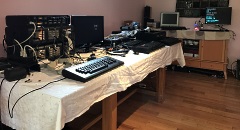 |
My
4x4 Video Wall
hardware, connected to the MTX512S2 that came with
the hotchpotch of Video Wall
kit that I obtained
in 2013.
In this photo you can also see the
prototype
Video board and
Z180 CPU board from MTXPlus+ as well as
one of the
replacement PSUs that Mark had built for Claus and
I.
(Photo courtesy of Andy) |
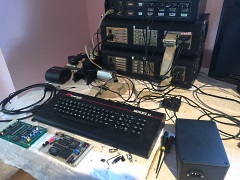 |
In this photo
you can see the video upscaler and switch box that I use
to display the 80 column TTL RGB output from my FDX or SDX
on a VGA monitor.
They are sat on the MTX2000
system unit with its associated keyboard in front. In
the foreground is my MTX512S2 and "new" style SDX disk
drive.
(Photo courtesy of Andy) |
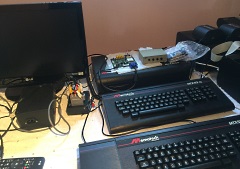 |
To the right of
those is my original FDX, upgraded with replacement 3.5"
disk drives and a
PC
power supply.
A second FDX is buried under
the two MTX PSUs, "old" style SDX disk controller with a
pair of 3.5" floppy drives and a collection 3.5" SDX/FDX
diskettes.
(Photo courtesy of Andy) |
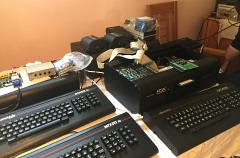 |
|
|
|
Demonstrations |
Andy demoed his
REMEMOTECH r2, upgraded to include enhanced floating
point support to allow it to outperform a 25Mhz Z180
MTXPlus+ when plotting the
Mandelbrot set - achieving a time of 82s!
In
"real world" applications, the Z180 MTXPlus+
still wins though :-)
Here you can see the
startup screen after REMEMOTECH has booted CP/M from
the SD card.
Further details of the REMEMOTECH
demo on Andy's site |
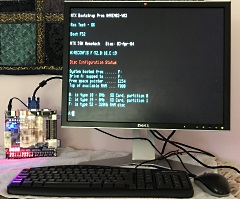 |
Andy's
REMEMOTECH in close up.
(Photo courtesy of
Andy) |
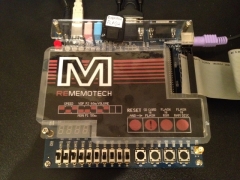 |
| |
|
Bill demoed his new hardware
add-on for the MTX. Bill had been a fan of
CFX, but not of
the 56 column screen limitation (based on Andy's SCPM
ROM) imposed on it by the MTX Video hardware.
Bill has designed and built an 80 column board that
emulates (and exceeds the capabilities of) the original
Memotech 80 column board and built his own prototype
PCB.
(Photo courtesy of Andy) |
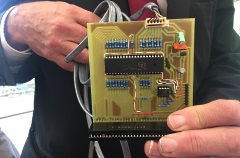 |
Solder side of Bill's home
etched PCB.
The main components (Parallax
Propeller, serial EEPROM, voltage regulator) are
available for around £10. See
here
for the technical details of Bill's board.
(Photo
courtesy of Andy) |
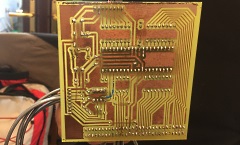 |
Sample output from Bill's 80
column board, mimicking the fonts of the original 80
column board and showing the improved range of 64 colours
available with Bill's board.
(Photo courtesy of
Andy) |
 |
Another sample of the output
from Bill's 80 column board - the photos do not do the
board justice, the quality of the output is really very
good. Everyone was most impressed by Bill's efforts and
agreed that it would be an ideal companion to CFX.
(Martin and Dave are likely to "borrow" Bill's work
(with permission) and look to add the functionality to
an improved CFX board.)
(Photo courtesy of Andy) |
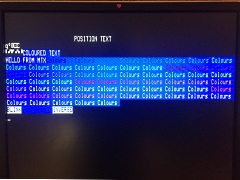 |
| |
|
Martin and
I demoed
MTXPlus+,
our MTX compatible "super computer".
The setup
you see here includes the first versions of the
"production PCBs for the backplane and video board,
along with the prototype
Z80 CPU, I/O and
6502
co-processor boards.
(Photo courtesy of
Andy) |
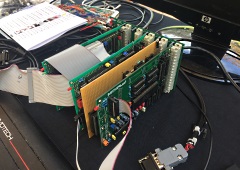 |
Martin demoed the 6502
co-processor running BBC 6502 BASIC.
More
details about the
6502
co-processor board
(Photo courtesy of
Andy) |
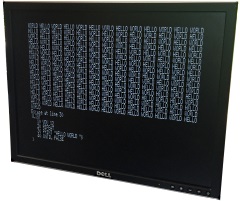 |
The demo included showing
MTXPlus+ displaying a number of the loading
screens from Sinclair ZX Spectrum games.
Tony
Brewer is helping us to implement a much enhanced
version of
Speculator on the system. This is currently a "work
in progress", but I think that we (well, Tony really) are
almost there. |
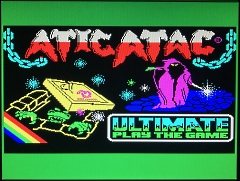 |
| |
|
Andy demoed his new game for
MTX - HEX-TRAIN, a Train
Simulator - with a difference.
The "game has animated 3D
solid graphics at 192x128, in 15 colours, at 16 frames
per second" - all done on a 4Mhz Z80 !
Read the full
details of how this is possible on
Andy's dedicated page. - go on, read it - you will
be in awe ! |
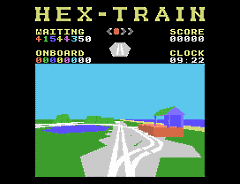 |
| Of course, the Memotech
community must take credit for "encouraging"
Andy to improve the 3D graphics he offered with
Turbo - HEX-TRAIN is
obviously the result of that - albeit that it
has taken 30+ years to get there ! |
 |
Seriously though, needless to say, everyone was very impressed with the
performance of the game and the huge amount of work that
Andy has put in to the developing the "engine" that
makes this impressive performance possible. |
Here you can see the "magic"
behind the demo - I am talking about Andy's magic coding
fingers - rather than the game engine!
After the
game demo, Andy tried to explain the complexities of
HEX-TRAIN to the mere mortals
in the room by showing us the internal workings of the
3d model and the "difference engine" used to allow such
complex graphics to be drawn by a 4MHz Z80 CPU! |
 |
The HEX-TRAIN
world!
Every possible route through the system is
modeled and stored in the game data file |
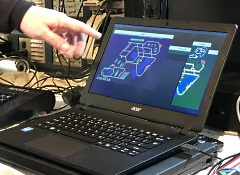 |
Part of the 3d model inside
HEX-TRAIN
My brief
notes here do not come anywhere close to doing justice
to this great piece of work - as I said - get over
to
Andy's page and read the full details. |
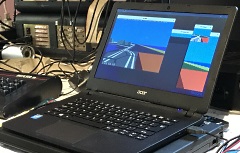 |
| |
|
I was a little disappointed to
find that HEX-TRAIN has
problems on MTXPlus+. I would like to understand why
that is, and hopefully, do something about it.
HEX-TRAIN is optimised for the
TMS-9929 VDP and there may be subtle differences in the
V9958 timing that are enough to break the program -
further investigation required. |
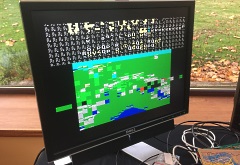 |
| |
|
As is usual on these occasions,
a Memotech themed cake was provided - this year's
offering is
shown here.
(Photo courtesy of
Andy) |
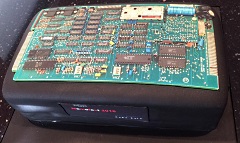 |
| |
 |
Despite the attractions of the
cake - you can see that the majority of the attendees
are engrossed in Andy's explanation of the inner
workings of HEX-TRAIN.
However, I can confirm that little persuasion was
required to drag them into the kitchen to attack the
cake!
Andy
further demonstrated his extensive range of skills by
ably wielding the cake knife and the group then
proceeded to regale Nicola and Julie with MTX related
anecdotes over tea & cake. (I will let you make your own
mind up on whether the "regaling" was appreciated or
not!). Some time was also taken to provide counseling to
Andy to help him cope with his return to Southampton's
answer to Imelda Marcos on Sunday morning. |
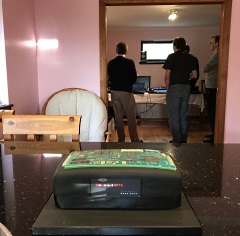 |
| |
|
Having made short work of his
cake . . . . .
Bill then demoed the
enhancements that he has made to
MEMU,
including the ability to load games from .wav files.
(Photo courtesy of
Andy) |
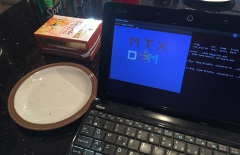 |
| |
|
|
After CakeFest,
Paul demoed the latest version of his
MTX game development engine, showing off some of the
impressive sound and graphics capabilities that the tool
allows to be integrated into games for the MTX.
(Photo courtesy of
Andy)
|
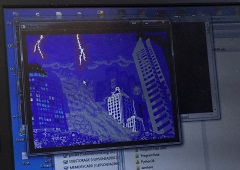 |
It would be really interesting
to see and hear a game for the MTX that took full
advantage of these impressive tools.
The group is
looking forward to seeing and hearing such a game from
Paul at Memofest 2017!
Paul - make it
so please :-)
(Photo courtesy of
Andy) |
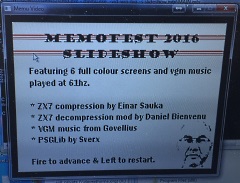 |
| |
|
Claus demoed his "new" game
conversion -
C-So!, originally released by
Sega
for the
SG-1000 video game console in 1985.
The
title screen from C-So!, complete with
Memofest 2016 banner ! |
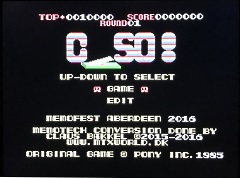 |
| C-So! is a platform type game -
with SeeSaws |
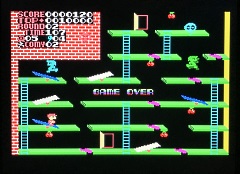 |
Claus demonstrating his gaming
skills on C-So!
The MTX keyboard that Claus is
using to play the game is attached to my
MTXPlus+
prototype that is running the game. |
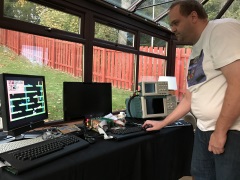 |
| |
|
Unfortunately, Bill had already
left when I found time to demo
MEMU-Pi, a Raspberry Pi running inside a real MTX
case running a version of MEMU that Bill had modified
for me.
The MTX keyboard is wired to the Pi GPIO
pins and Bill has patched the keyboard routines in MEMU
to read the MTX keyboard through the GPIO pins. |
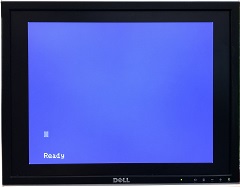 |
I have made a small,
reversible, change to the keyboard to allow the two
unmarked keys to be separately sensed.
The
unmarked key on the right hand side is used to invoke
the MEMU-Pi menu. |
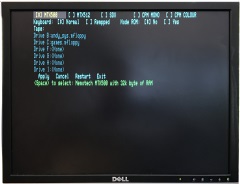 |
| |
|
The usual "Memotech Hospital"
was planned, but there was little call on its services.
The only patient booked in in advance was the video
board from Paul's MTX.
Paul couldn't bring the
whole MTX to Aberdeen, so brought the Video daughter
board on the basis that it had failed previously (but
had already been repaired by Mark). However, testing
showed that the Video board was fine and there must be
another fault on the machine now. |
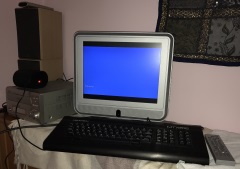 |
| |
|
Despite only having one monitor
connected to the output, and a problem with the MTX512S2
that was connected to it (see below), I, or rather
Andy,
was able to demonstrate operation of the Video Wall
hardware.
In this photo, the Video Wall prompt
monitor output is being fed to the
Decoder/Distribution Amplifier (DDA) input. |
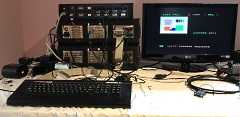 |
The MTX512S2 that we were using
to control the Video Wall electronics came from my other
collection of Video Wall hardware.
It appears
that the
DDFS units in the Video Wall are of an older vintage
than the S2 and do not support some of the features,
e.g., Colour Wash, configured in the S2 software.
Despite this, Andy was able to show the system running
some of the video sequences stored in the S2 ROM. |
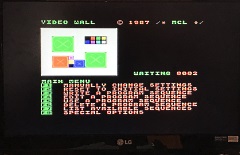 |
With the TV/monitor plugged
into the appropriate DDFS output, you can see that this
is the top left corner of the input signal being
magnified by the DDFS and output to the (very small)
Video Wall.
(Photo courtesy of Andy) |
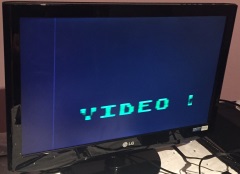 |
| The prompt monitor display when
a Video Wall sequence is running |
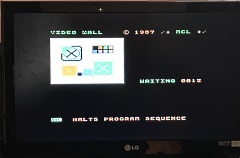 |
| Another section of the tiled
display |
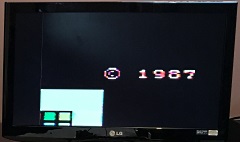 |
| Another section of the tiled
display |
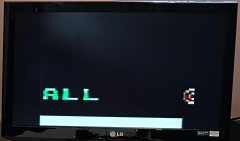 |
| Another section of the tiled
display |
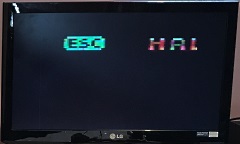 |
| |
|
I was aware of a problem with
the MTX512S2 attached to my Video Wall system, after
about 20 minutes, the picture would lose colour, then a
little later, would break up completely. The machine was
running very hot - particularly around the power input
capacitor and I suspected that one of the voltage
regulators was faulty, but I had not had time to
find/fix the problem before Memofest.
During the
Video Wall demo, using copious amounts of freezer spray
(ably applied by Mark), were were able to narrow the
problem down to the LM7812 (+12VDC regulator). |
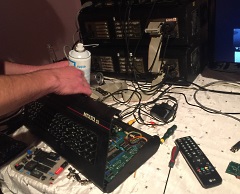 |
A wider angle view of Mark
delving inside the Video Wall MTX512S2
As you can
see, working on retro computers can be thirsty work! |
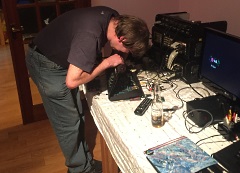 |
| |
|
The die-hards (Mark, Martin & I) resumed
on Sunday morning, refreshed after the extra hour in bed
courtesy of the DST change, we were able to spend
another whole day on geek speak!
Claus and Andy
were both flying back home on Sunday morning, but they
met for breakfast out at their airport hotel before they
flew. To help Claus get his body clock back in sync, it
was very considerate of Andy to forgo the extra hour in
bed and join Claus for breakfast at Swedish time :-) |
| |
|
A selection of my other
Memotech computers were on display, including the 4 you
see here. (The one missing its keyboard on top of the
toolbox is my original MTX512 - the keyboard is
currently being used on MTXPlus+ ).
On
Sunday, we proved that the other three you see here are
all working fine, including the MTX-500 with the German
keyboard that I received from Manfred Flume recently and
modified to use a Cisco
DC only power supply. |
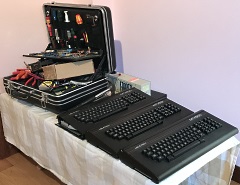 |
| |
|
| Mark obviously enjoyed his
visit to Scotland and took the opportunity to
see a little more of the UK on his way home to
Bristol! |
 |
| |
|
| As in previous years, despite the
intention of having a game High Score competition, we
got sidetracked and didn't actually manage to fit in
enough time for the competition - maybe next time . . .
. . . |